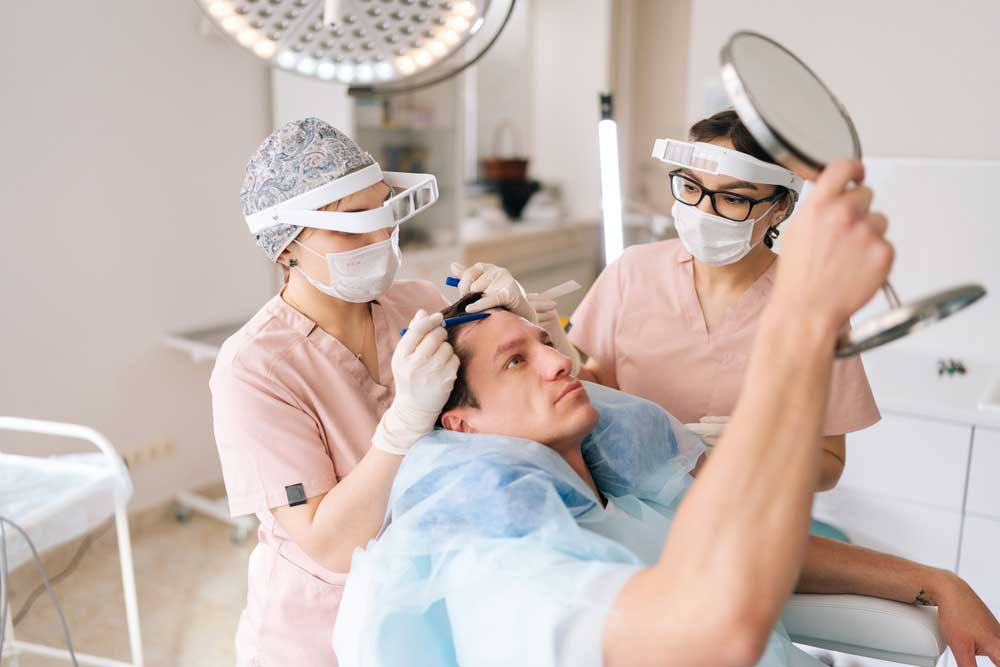Hair loss can be a challenging experience, but advancements in medical technology have opened up several avenues for effective treatment. The follicular unit transplantation (FUT) technique is one of the most reliable solutions. We specialize in this proven method at New Jersey Hair Restoration Center in Freehold, NJ, offering our patients a path to regain fuller, natural-looking hair. This guide will explore what FUT involves, how it compares to other methods, and why it might be the right choice for you.
Understanding FUT Hair Restoration
Follicular unit transplantation is a hair restoration procedure that involves removing a strip of tissue from the donor area at the back of the head, where hair typically grows more densely and is more resistant to balding. The tissue is then meticulously dissected under a microscope into individual follicular units containing one to four hairs each. These units are then implanted into the thinning or balding areas of the scalp.
How Can You Benefit From a FUT Hair Transplant?
Significant Hair Density
FUT allows for the transplantation of many follicular units in a single session. This can dramatically increase hair density, effectively covering more significant areas of baldness. It’s especially beneficial for those with considerable hair thinning or bald patches who seek a substantial improvement in hair coverage.
Natural-Looking Results
The technique used in FUT involves transplanting hairs in their natural grouping, which helps achieve a more natural appearance. The transplanted hair grows in its natural direction, blending seamlessly with existing hair and making it difficult to distinguish between transplanted and original hair once fully grown.
Long-Term Solution
Hair transplanted via FUT generally continues to grow for a lifetime. The donor area from which the strip is taken is usually genetically resistant to balding, which means the transplanted hair maintains this characteristic. This makes FUT a long-term or even permanent solution to hair loss.
Straightforward Procedure
For many patients, a single FUT session is sufficient to achieve the desired results, depending on the extent of hair loss and the size of the transplant area. This procedure aspect can be particularly appealing for those looking to minimize downtime and the frequency of medical visits.
Versatility in Hair Styling
With increased hair density and coverage, individuals have more hair styling options. This versatility can be particularly important for those who feel limited by their hair loss when trying to style their hair in specific ways.
Postoperative Recovery
Though FUT requires a recovery period, postoperative care is generally straightforward, and many individuals can return to work within a couple of weeks. While the linear scar is a consideration, it can typically be hidden under existing hair unless worn very short.
FUE vs. FUT: Understanding the Differences
While FUT involves removing a strip of scalp tissue, follicular unit extraction (FUE) involves harvesting individual hair follicles directly from the scalp without needing a strip removal. This method reduces scarring and can be ideal for patients who prefer to wear short haircuts or those with limited donor hair.
However, FUE typically requires more time and can be costlier than FUT due to the meticulous nature of the follicle extraction. On the other hand, FUT allows for a more significant number of grafts to be transplanted in a single session, often making it more suitable for patients requiring extensive coverage.
What Should You Anticipate From a FUT Hair Transplant Procedure?
During the Procedure
Preparation
The FUT procedure is typically performed under local anesthesia to numb the scalp area, particularly where the hair will be harvested, usually the back of the head.
Harvesting the Hair
During the procedure, a strip of scalp skin containing multiple hair follicles is surgically removed from the donor area. The size of the strip is determined based on the number of grafts needed.
Suturing
After the hair is harvested, the area from where the strip was taken is sutured closed. This leaves a linear scar that is generally concealed by your existing hair.
Preparation of Follicular Units
The harvested strip is then carefully dissected into small follicular units under a microscope. Each unit contains one to four hairs prepared for transplantation.
Transplantation
The surgeon makes small incisions in the balding areas of your scalp. The follicular units are then inserted into these incisions, miming natural hair growth.
After the Procedure
Recovery
Some swelling, tenderness, and bruising around the scalp are common post-surgery. The sutures where the strip was removed are typically removed about 10 days after the procedure.
Post-operative Care
You will receive detailed instructions on how to care for your scalp following the surgery. This care regimen includes gentle washing and may involve taking antibiotics to prevent infection. It’s also recommended to avoid strenuous activities and direct exposure to sunlight during the initial healing phase.
Hair Growth
It is usual for the transplanted hair to shed within the first few weeks as part of the natural growth cycle. New hair growth should begin within a few months, and the full results of the transplant are typically visible within a year, culminating in a more filled-in hairline.
Discover the Natural-Looking Results of a FUT Hair Transplant in Freehold, NJ
FUT hair transplant offers a reliable and effective solution for those suffering from significant hair loss. Its ability to provide natural-looking and dense results makes it a popular choice among patients. At the New Jersey Hair Restoration Center in Freehold, NJ, we provide top-tier care and detailed follow-through to ensure you achieve the best possible outcome. Contact us online or call (732) 365-4533 to learn how FUT can restore your hair and renew your outlook on life.


